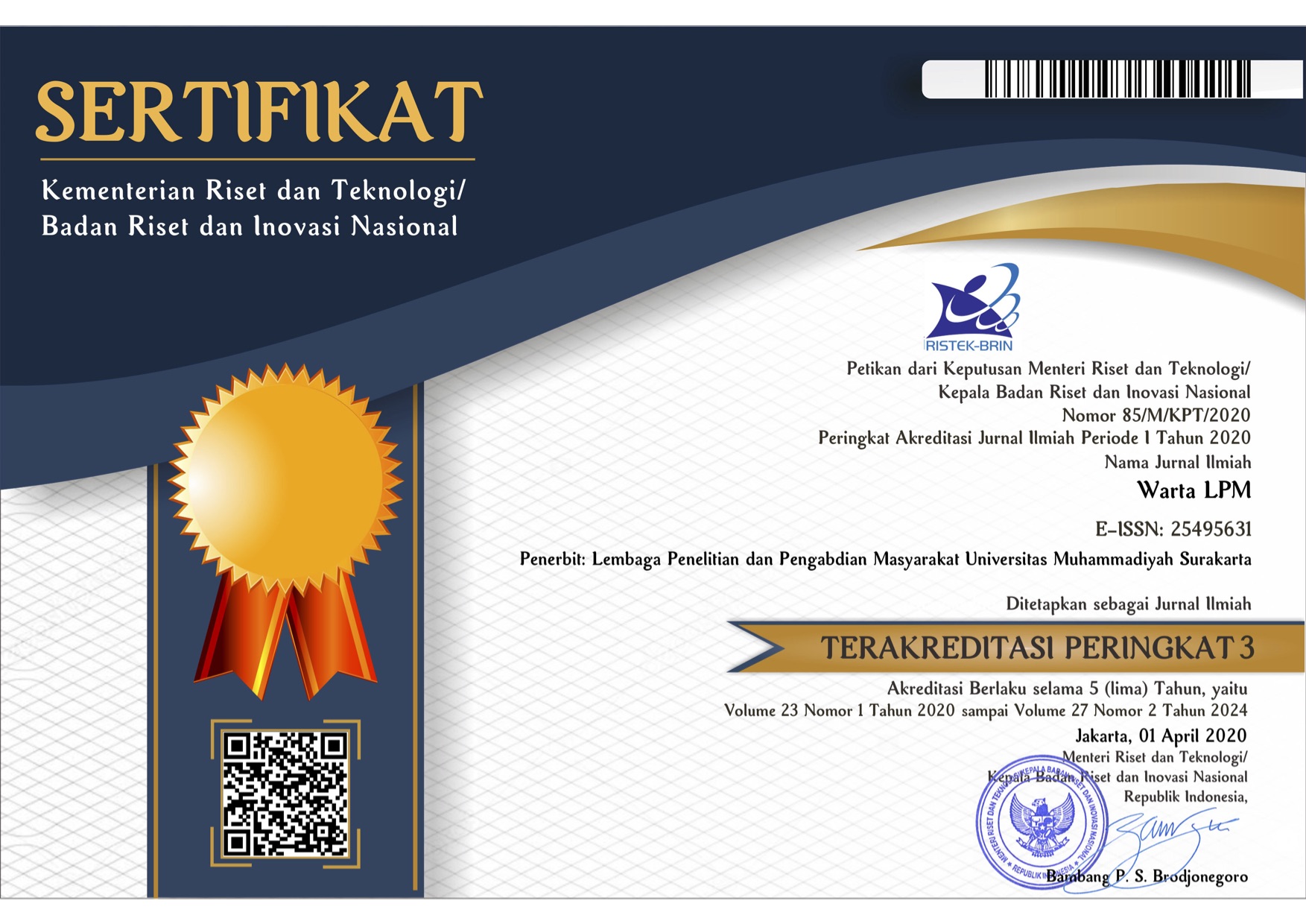Pelatihan Pengembangan Model Pembelajaran Menulis Teks Deskripsi dengan Picture Word Inductive Model
Jumariati Jumariati(1*), Eka Puteri Elyani(2), Rizky Amelia(3), Khairin Utomo(4), Mardatilah Nadya Ramadanty(5), Rika Rianti(6)(1) Universitas Lambung Mangkurat
(2) Universitas Lambung Mangkurat
(3) Universitas Lambung Mangkurat
(4) Universitas Lambung Mangkurat
(5) Universitas Lambung Mangkurat
(6) Universitas Lambung Mangkurat
(*) Corresponding Author
Abstract
Writing skills are rarely taught since many teachers encounter issues such as students' poor command of English vocabulary, inability to write in the correct English format, insufficient time allotted to aid each student, and a lack of teacher expertise regarding teaching strategies. For students, appropriate writing skills are required. Activities such as training for English teachers on approaches for teaching suitable and engaging writing skills to students are required. The Picture Word Inductive Model will be taught as a tool for practicing writing descriptive text abilities. This activity employs a participatory technique based on Kurt Lewin's theory, which stresses the target participants' active participation throughout the training process, from participating in training activities to completing training assignments. A total of 15 teachers from various agencies in Kabupaten Banjar participated in this community service project. Starting with the explanation, questions and answers session, small group discussions, reflection, and evaluation, the exercise went off without a hitch. The Picture Word Inductive Model is a learning paradigm that they have just acquired and will employ in teaching writing. Because there were steps of categorizing and refining it into phrases and paragraphs, participants concluded that utilizing this model would be better than using visual media. As a result, they can assist students with their writing. In a nutshell, English teachers in Kabupaten Banjar have a good conceptual understanding of how to teach descriptive text writing skills. Finally, the participants were able to create a learning plan for writing descriptive text skills using Picture Word Inductive Model.
Keywords
Full Text:
PDFReferences
Alagozlu, N. (2007). Critical Thinking and Voice in EFL Writing. The Asian EFL Journal Quarterly, 9(3), 118–136.
Ani, F. (2020). An Analysis on the English Teachers’ Strategies in Teaching Descriptive Writing through Online Class at the Seventh Grade of SMPN 3 Gubug in the Academic Year 2019/2020. IAIN Salatiga.
Arihasta, D., & Basthomi, Y. (2019). Project-Based Learning, Process Writing, and Instagram: an Attempt to Enhance the Students’ Writing Skill. Jurnal Pendidikan Humaniora, 7(3), 76–84.
Bayat, N. (2014). The Effect of the Process Writing Approach on Writing Success and Anxiety. Educational Sciences: Theory and Practice, 14(3), 1123–1141. https://doi.org/10.12738/estp.2014.3.1720
Brown, H. D. (2002). Teaching by Principles: An Interactive Approach to Teaching Pedagogy (2nd ed.). Addison Wesley.
Brown, H. D., & Heekyeong, L. (2015). Teaching by Principles: An Interactive Approach to Language Pedagogy (4th ed.). White Plains, NY : Pearson Education.
Cahyono, B. Y., & Widiati, U. (2011). The Teaching of English as a Foreign Language in Indonesia. State University of Malang Press.
Cheung, Y. L. (2016). Teaching writing. In English Language Teaching Today: Building a Closer Link Between Theory and Practice (pp. 1–20). Springer. https://doi.org/10.1007/978-3-319-38834-2
Drajati, N. A., & Tim. (2019). Pembelajaran Bahasa Inggris SMA/ SMK/ MA dengan Kerangka TPACK Teori & Praktik. Yuma Pustaka.
Gilakjani, A. P. (2016). English Pronunciation Instruction: A Literature Review. International Journal of Research in English Education, 1(1), 1–6. http://ijreeonline.com/article-1-21-en.html
Graham, S., & Sandmel, K. (2011). The Process Writing Approach: A Meta-analysis. The Journal of Educational Research, 104(6), 396–407. https://doi.org/10.1080/00220671.2010.488703
Harmer, J. (2004). How to Teach Writing. Pearson Education Limited.
Hedge, T. (2015). Process Writing.
https://www.birmingham.ac.uk/Documents/college-artslaw/cels/essays/languageteaching/TheProcessApproachGhosal.pdf
Husain, N. (2015). Language and Language Skills. In Language and Language Skills (Issue March). https://www.researchgate.net/publication/274310952
Johari, S. K. (2018). The Effects of Task-Based Process Writing Approach on the Academic Writing Skills among Second Language Tertiary Learners. Journal of ELT Research, 3(1), 1–20. https://doi.org/10.22236/JER
Jumariati, J., & Sulistyo, G. H. (2017). Problem-Based Writing Instruction: Its Effect on Students’ Skills in Argumentative Writing. Arab World English Journal, 8(2), 87–100. https://doi.org/10.24093/awej/vol8no2.6
Kaya, H. (2008). Blending Technology with Constructivism: Implications for an ELT Classroom. Teaching English with Technology, 15(1), 3–13. https://doi.org/10.1002/9780470294673.ch1
Lotherington, H. (2004). What Four Skills Redefining Language and Literacy Standards for ELT in the Digital Era. In TESL Canada Journal (Vol. 22, Issue 1, pp. 64–78).
Lusita, J., & Emidar, E. (2019). Struktur dan Unsur Kebahasaan Teks Deskripsi Siswa Kelas Vii Smp Negeri 30 Padang. Jurnal Pendidikan Bahasa Indonesia, 8(1), 113–120. https://doi.org/10.24036/103924-019883
Montanarogers. (2021). Show, Don’t Tell: 8 Delicious Activities for ESL Descriptive Writing Classes.www.Fluentu.com.https://www.fluentu.com/blog/educator-english/esl-descriptive-writing/
Muslimah, A. (2018). Teaching Techniques for the Tenth Grade Students of SMA Muhammadiyah Surakarta in the Academic Year 2017/2018. Universitas Muhammadiyah Surakarta.
Raimes, A. (1983). Techniques in Teaching Writing. Oxford University Press.
Sabrina, K., Kamaluddin, K., & Sapan, Y. T. (2020). The Effect of Pwim (Picture Word Inductive Model) on Students’ Competence in Writing Narrative Text. Journal of Teaching English, 5(3), 306–317. https://doi.org/10.36709/jte.v5i3.13868
Seow, A. (2002). The Writing Process and Process Writing. In J. Richards & W. Renandya (Eds.), Methodology in Language Teaching: An Anthology of Current Practice (Cambridge Professional Learning, pp. 315-320). Cambridge: Cambridge University Press. doi:10.1017/CBO9780511667190.044
Sharma, H. L., & Poonam. (2016). Constructivist Approach for Teaching English: Making Sense of Paradigm Shift from the Traditional Approach. Article in International Journal of Science and Research, 5(10), 788–792. www.ijsr.net
Suhartoyo, E., Mukminatien, N., & Laksmi, E. D. (2015). The Effect of Toulmin’s Model of Argumentation Within TWPS Strategy on Students’ Critical Thinking on Argumentative Essay. Jurnal Pendidikan Humaniora, 3(2), 143–153. http://journal.um.ac.id/index.php/jph
Suraya, D., Novita, D., & Fergina, A. (2017). The Effect of Using Picture Word Inductive Model on Teaching Descriptive Text Writing. Jurnal Pendidikan dan Pembelajaran Khatulistiwa, 6(2), 1–10.
Ulfah, A. (2020). Teachers’ Problems in Teaching Writing Descriptive Text to the Eight Grade Students of SMPN 2 Kandangan. Universitas Lambung Mangkurat.
Viera, R. T. (2017). Vocabulary knowledge in the production of written texts : a case study on EFL language learners. Revista Technologica ESPOL - RTE, 30(3), 89–105.
Article Metrics
Abstract view(s): 467 time(s)PDF: 268 time(s)
Refbacks
- There are currently no refbacks.









